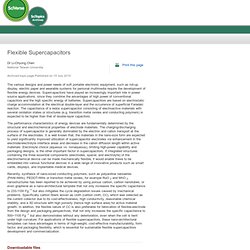

Light-rechargeable batteries. Capacitators. Flexible Supercapacitors. The various designs and power needs of soft portable electronic equipment, such as roll-up display, electric paper and wearable systems for personal multimedia require the development of flexible energy devices.

Supercapacitors have played an increasingly important role in power source applications, since they combine the advantages of high power of conventional capacitors and the high specific energy of batteries. Supercapacitors are based on electrostatic charge accommodation at the electrical double-layer and the occurrence of superficial Faradaic reaction.
The capacitance of a redox supercapacitor consisting of electroactive materials with several oxidation states or structures (e.g. transition metal oxides and conducting polymers) is expected to be higher than that of double-layer capacitors. Next Stop: Ultracapacitor Buses. Municipal transit agencies have tried to reduce the carbon footprint of their bus fleets using a range of options over the years, from biofuels and hydrogen to batteries and hybrid-electric diesel.

Now a Chinese company and its U.S. partner say that ultracapacitors could offer the greenest and most economical way of powering inner-city buses. There’s just one catch: the best ultracapacitors can only store about 5 percent of the energy that lithium-ion batteries hold, limiting them to a couple of miles per charge. This makes them ineffective as an energy storage medium for passenger vehicles. Electric double-layer capacitor. Electrical double-layer capacitors (EDLC) are, together with pseudocapacitors, part of a new type of electrochemical capacitors[1] called supercapacitors, also known as ultracapacitors. Supercapacitors do not have a conventional solid dielectric. The capacitance value of an electrochemical capacitor is determined by two storage principles: Double-layer capacitance and pseudocapacitance both contribute to the total capacitance value of a supercapacitor.[3] However, the ratio of the two can vary greatly, depending on the design of the electrodes and the composition of the electrolyte.
Pseudocapacitance can increase the capacitance value by as much as an order of magnitude over that of the double-layer by itself.[1]